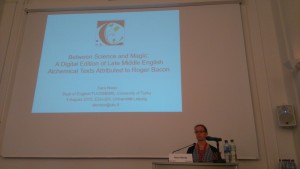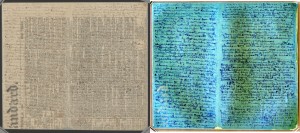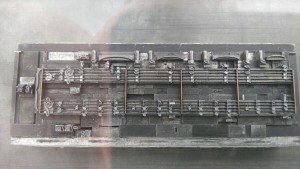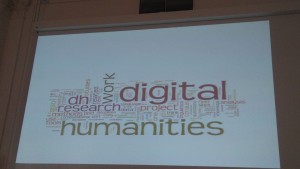
It’s not summer for a doctoral student if it doesn’t include an intensive training week or two. We two intrepid travellers from the Department attended the sixth European Summer University in Digital Humanities (ESU DH), “Culture and Technology”, held at Universität Leipzig July 28-August 7.
Founded by Prof. Elisabeth Burr, ESU DH is a multilingual, multidisciplinary forum for young digital humanists of all stripes. The summer university offers a great number of workshops on topics ranging from programming languages and editorial principles to software tools. In addition to the two workshops taken by each participant, we were treated to a number of lectures and project presentations, poster sessions, panels and even two science slams. (Our workshop won the first one!) One of the most rewarding aspects of ESU DH was discussions with people hailing from various disciplines, united by our interest in the digital applications of humanities research.

We both attended the two-week workshop “Digital Editions and Editorial Theory: Historical Texts and Documents”. The first week, taught by Dr. Johanna Green (University of Glasgow), concentrated on (digital) editorial theory, using online editions of historical texts to highlight issues discussed. Both of our doctoral dissertations deal with historical texts in digital environments, so the workshop’s content had great practical value. Sara’s doctoral dissertation incorporates a digital edition of early English texts, while Sirkku’s involves a corpus of Renaissance paratexts. Both benefit from the instruction in editorial theory. Hence one of the highlights of the workshop was the theoretical discussion on different digital editions already published online, which gave insight into the options available for future work. The editions varied in presentation and style from The Dream of the Rood to Jane Austen’s Fiction Manuscripts and The Chymistry of Isaac Newton.
The second week, taught by Kathryn Simpson (Edinburgh Napier University), was more hands-on, introducing us to the world of XML-encoded digital editing using material from the Livingstone Online Project. The project has collected a sizeable number of Livingstone’s field diaries, used spectral imaging technology to bring out the (often rather illegible) diary page, and is in the process of producing a digital edition. We got to participate in the project through transcribing pages from David Livingstone’s field diaries into XML using OXygen.

Livingstone, 1871 Field Diary, 297b/157-138 in color (left) and spectral ratio (right).
Image credit: Livingstone Online Project (CC).
Despite the full schedule, ESU DH managed to include a plethora of social events including coffees and communal dinners, as well as excursions to local museums and parks. The evening activities were slightly hampered by the heat, which climbed close to 40 degrees celsius (!) Thankfully the school itself was air conditioned. Since Leipzig celebrates its 1000th year as a city in 2015, there was too much to see to let the heat bother us. (Including a really rather convincing Elvis impersonator performing in a free open air concert on our final evening.) The highlight of the events for us was the visit to the Museum für Druckkunst, a printing history museum with a collection of several dozen printing presses, type foundries, and a number of historical print products, including their collection of incunabula.

All in all, the summer university was a fantastic experience and we both highly recommend it for anyone interested in, or doing research on, digital humanities.
Text: Sara Norja and Sirkku Ruokkeinen
Cover image credit: Maciej Eder (Uniwersytet Pedagogiczny, Kraków, Poland)
